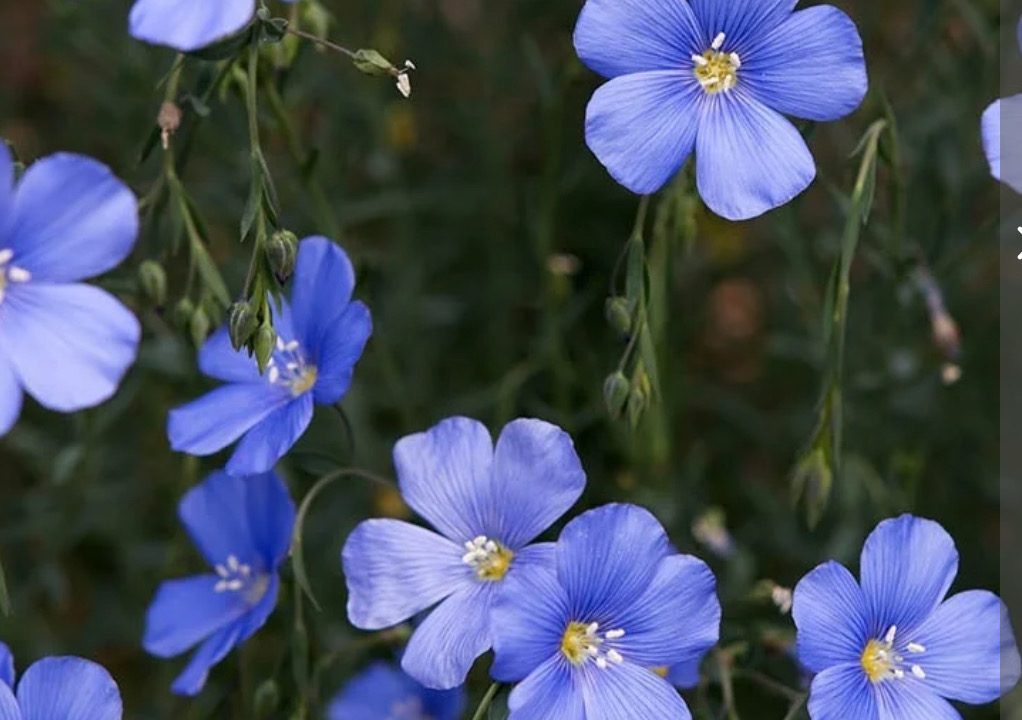This month our resident gardening expert, Alison Agnew, has some ideas on how the blues can bring a bit of cheer to our gardens at this time of year. But first, standby for a bit of bioscience.
Tangled up in blue
I’ve been admiring two plants in a very dry border along the house wall: the very useful small shrub Ceratostigma wilmottiana and herbaceous Salvia patens Big Blue. Both have been flowering since late July and look set to continue into November. Both have true blue flowers – a colour that is quite rare. I’ve often wondered why but have been too lazy to search for answers. Writing this has given me an excuse to tangle with the evidence.
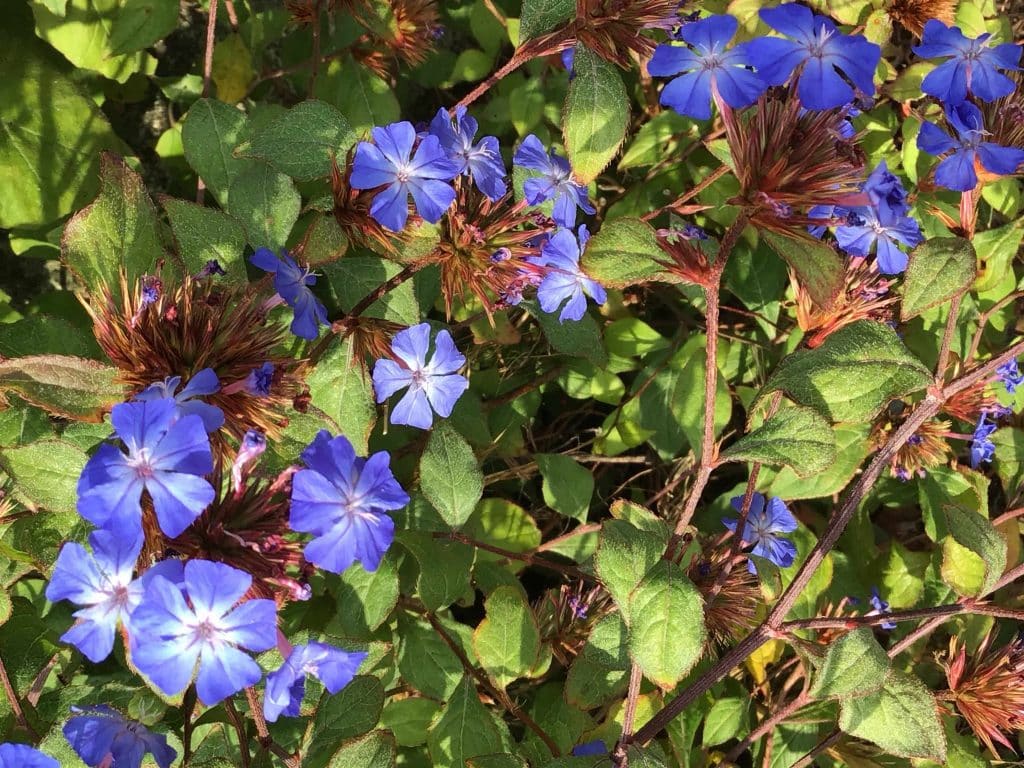
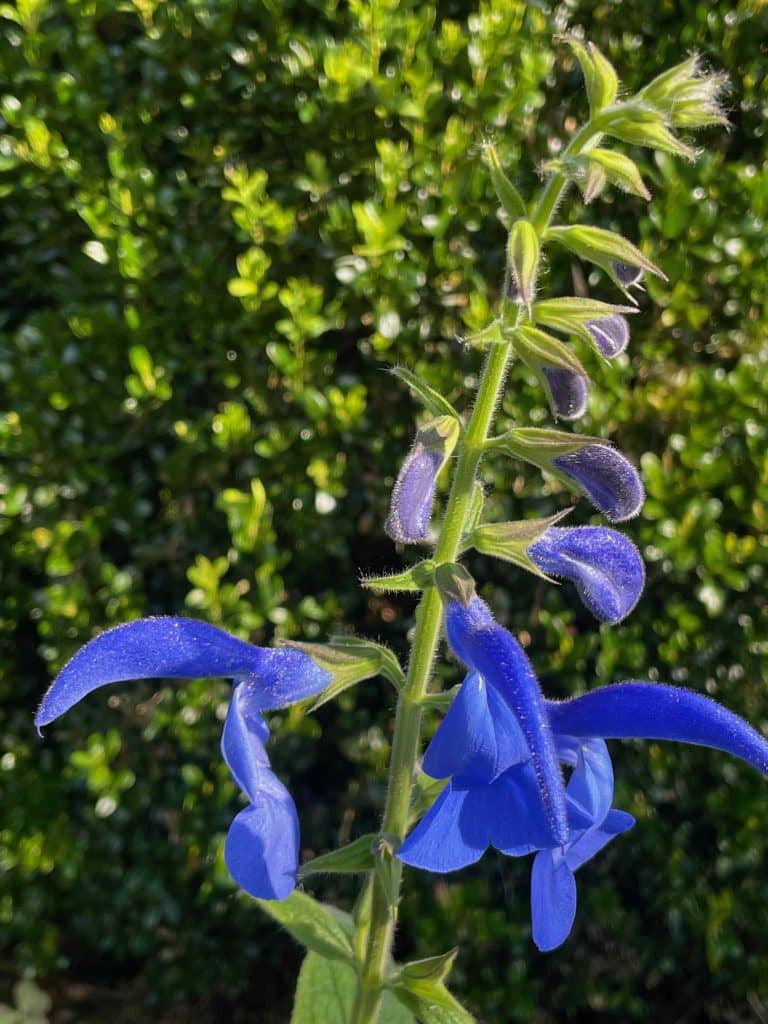
Reasons why true blue is rare
Colour in nature is produced in one of two ways: either by pigments that absorb other wavelengths of light and reflect those that we can then detect, or by diffraction of light – the scattering of wavelengths other than the ones we detect. The latter often contributes to colour in birds feathers and insect wings. The former is used in plants.
Plants produce a large array of pigments. The one people are most familiar with is chlorophyll. This make leaves look green because it absorbs the red wavelengths that provide the energy for the fixation of carbon in the process of photosynthesis. But plants have evolved many other pigments – some are used as accessory pigments in photosynthesis absorbing different wavelengths at low light levels. Many are used as colourants to encourage interactions with pollinators, or animal agents of dispersal, or to discourage interactions with predators.
I found the simplest explanation for blue scarcity in a Wikipedia entry (don’t you love Wiki!). Blue colour in flowers is generated by pigments in one class of anthocyanins – the delphinidins (the other two classes produce red and orange colouration). It seems that the reason why blue is so much rarer a colour is that blue cannot be produced simply by the presence of delphinidin molecules but needs to be complexed with other molecules or with metal ions. In addition, the pH within the cells can also potentially alter the colour expressed. To put it very simply – making blue is just a whole lot more complicated than making other colours. So why does it ever occur?
Well – as Darwin taught us – life is all about competition and avoiding it. Pollinating insects co-evolved with flowering plants so variety of form and colour are tailored to different groups of insects. For example, bees apparently favour flowers in the blue/purple range while fly pollinators favour yellow tones. Specialisation can increase reproductive advantage – even when it’s a costly process.
Science bit over – I’ve tried to make it as simple as possible – please forgive me if I’ve tipped over into the simplistic.
Best of the blues
Annuals
There are a few well known annuals that have blue flowers: Nemophila menziesii – Baby Blue Eyes, a native of North America; Nigella damascena– Love-in-the-mist, a European native; Lysimachia monelii – the blue pimpernel; Myosotis sylvatica the garden Forget-me-not, and Centaurea cyanus – our native cornflower.
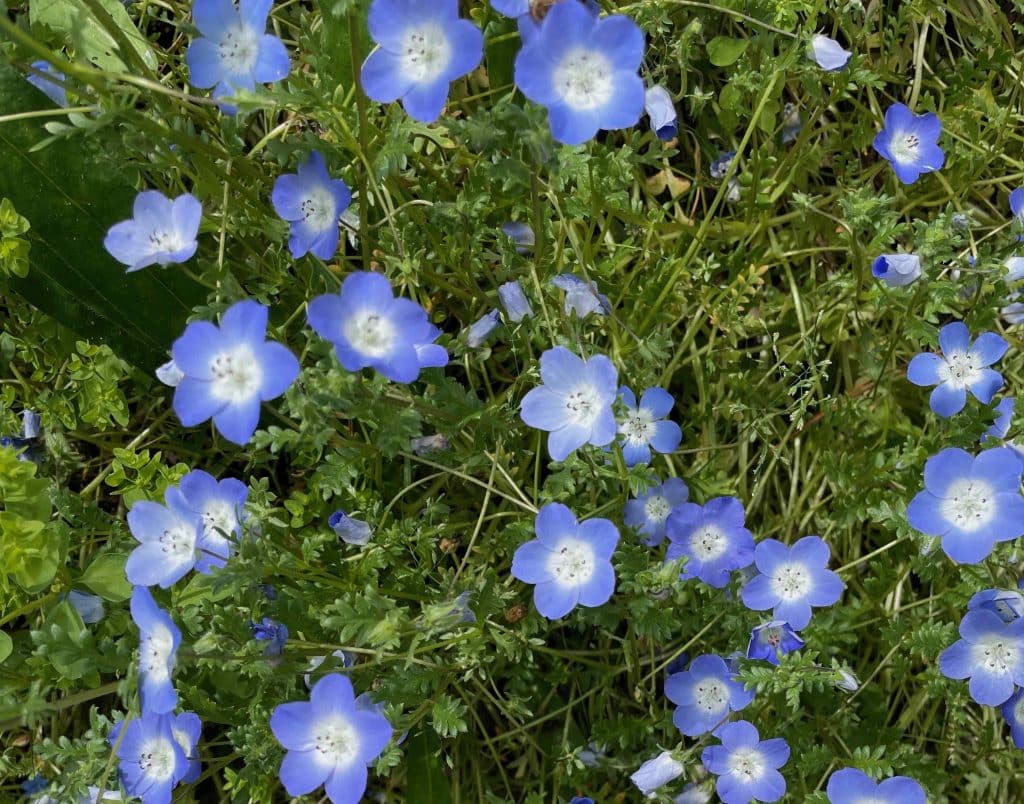
Perennials
Agapanthus – needs no introduction in this area – most are blue.
Commelinas – are related to the better-known houseplants, the Tradescantias. They are sprawling perennials with the same three-petalled flowers but are usually true blue. Commelina tuberosa and C. dianthifolia could be useful front of border plants.
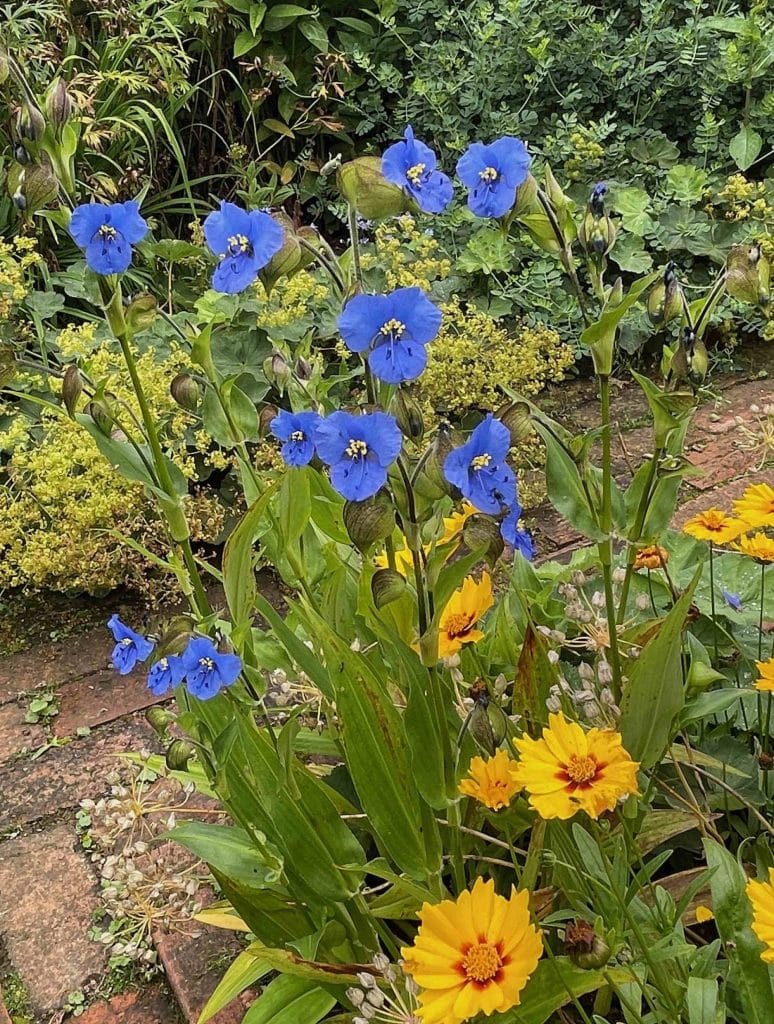
Delphiniums
I don’t grow Delphiniums – lovely though they are, they are heartbreakers – so beloved by slugs that they are eaten underground before they even think about emerging in the Spring. Though we think of them as blue, many varieties have purple tones or are both blue and purple. A good true sky blue variety is Magic Fountains – if you can afford to plant slug food.
Gentians are famously blue – most are low growing alpine plants. I’m not sure I like them despite their colour – their heads are too big for their bodies.
Jasione maritima – the Sheep’s Bit Scabious that grows on the cliffs. The larger-flowered species, Jasione laevis, requires the same dry and sunny conditions and makes a good mat of foliage from which the little scabious-like flowers rise and nod in the wind.
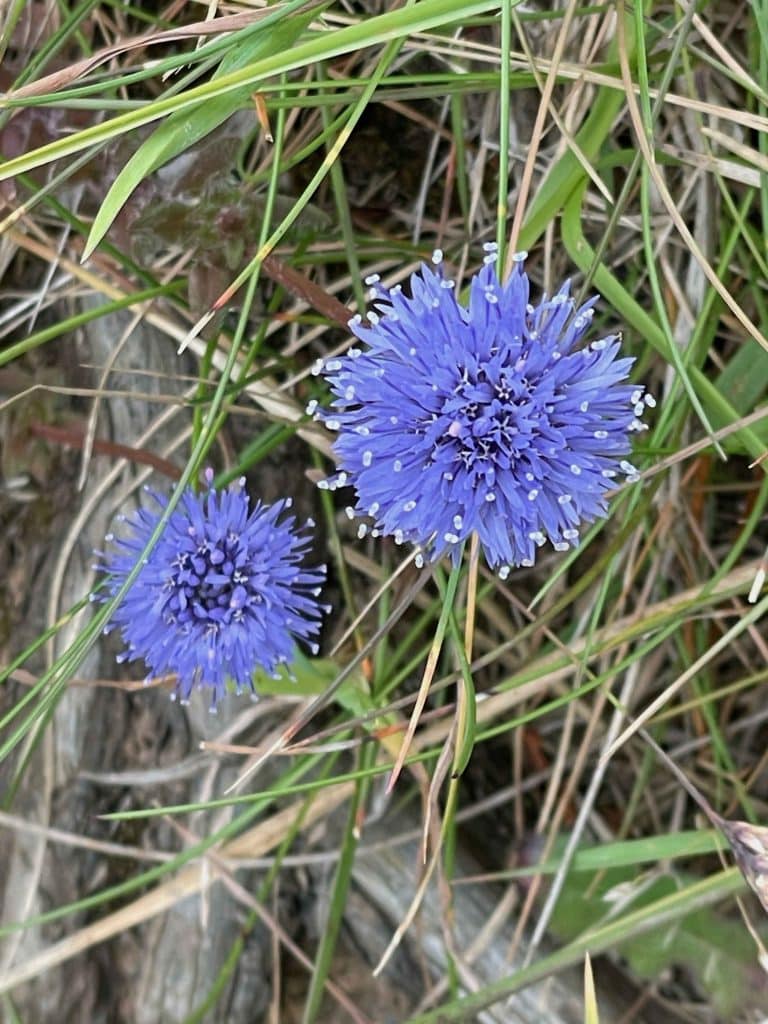
Linums
Several flax species have blue flowers – the species grown for fibre and oil is
Linum usitatissimum – a fantastic sight in the fields to the west of Pendower beach last year. Linum narbonense and Linum perenne are shorter and make better garden plants but have the same clear blue open flowers on fine wafty stems. Grow them from seed – Chiltern Seeds stock them.
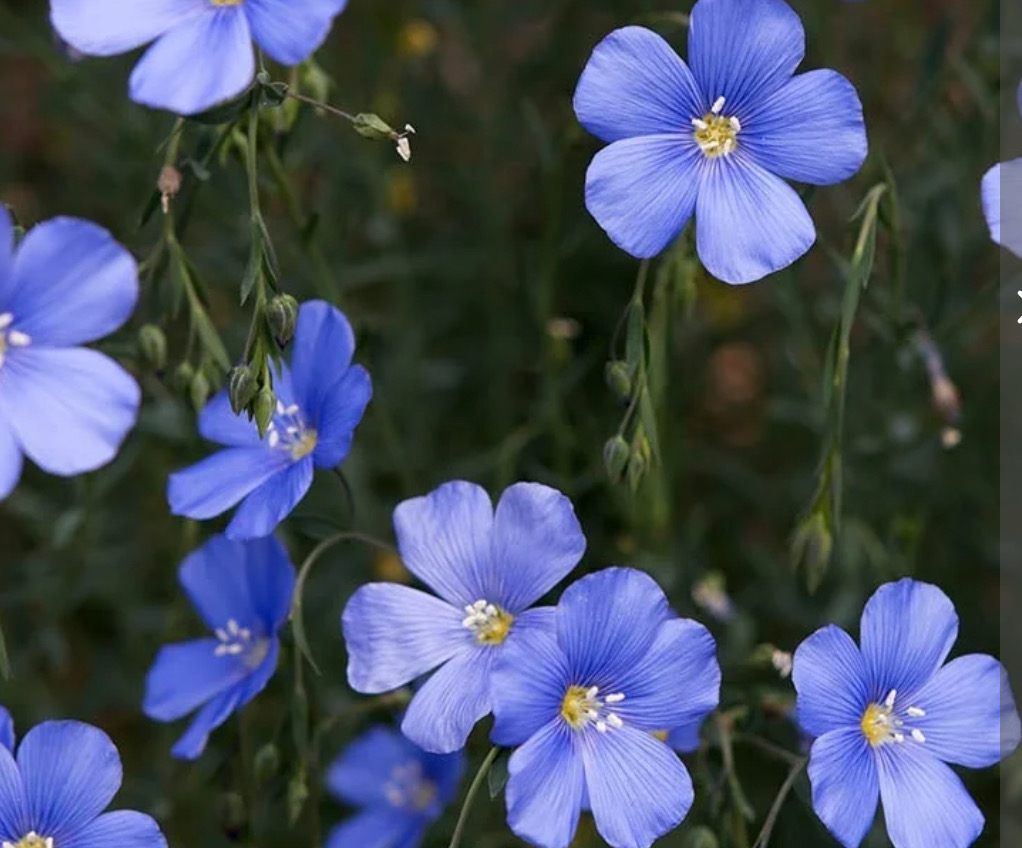
Meconopsis betonicifolia – the blue Himalayan poppies – are a lovely cerulean blue. They need damp but well-drained and cool temperatures to thrive. I’ve done OK with them here for a few years and then a hotter summer has knocked them out. They do best in the west of Scotland not in Cornwall – despite our damp.
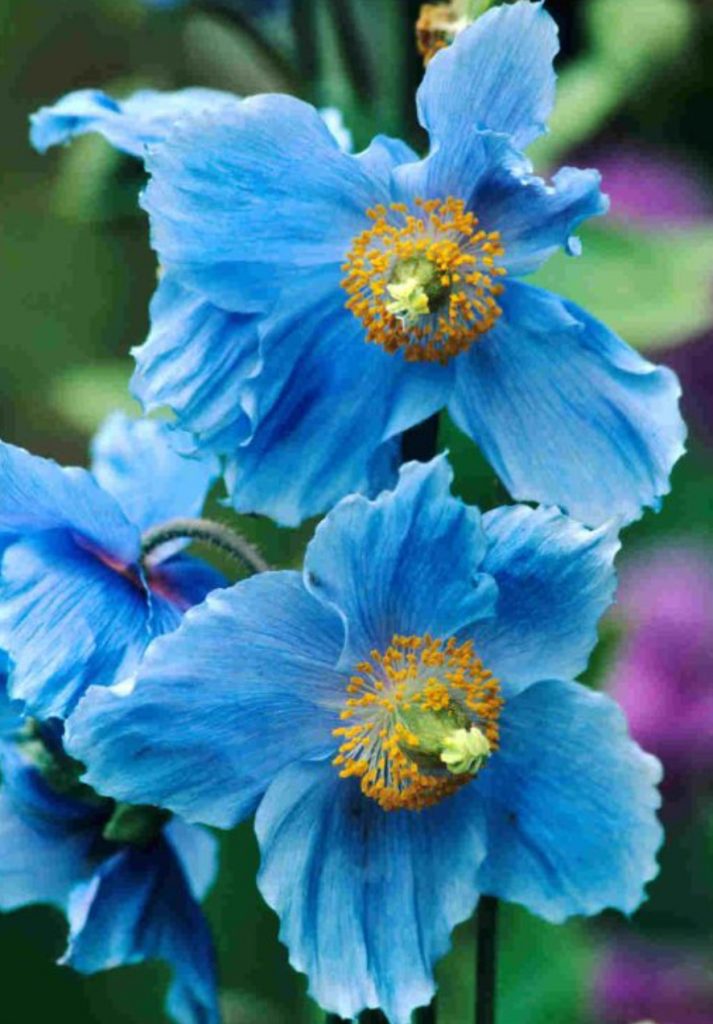
Myosotidium hortensia – the Chatham Island Forget-me-not. This is a truly blue and truly splendid plant if you find the right spot for it. It has large glossy strongly ribbed green leaves and huge sprays of outsized forget-me-not flowers. I bought a single plant some years ago and put it under a Cupressus in poor soil until could find a better spot for it. It amazed me by thriving and seeding many offspring in this poverty-stricken spot. When I moved it to a ‘better’ location it died out! I should have read up about its natural habitat – it occurs near beaches exposed to salt laden winds so it should do well on the Roseland!
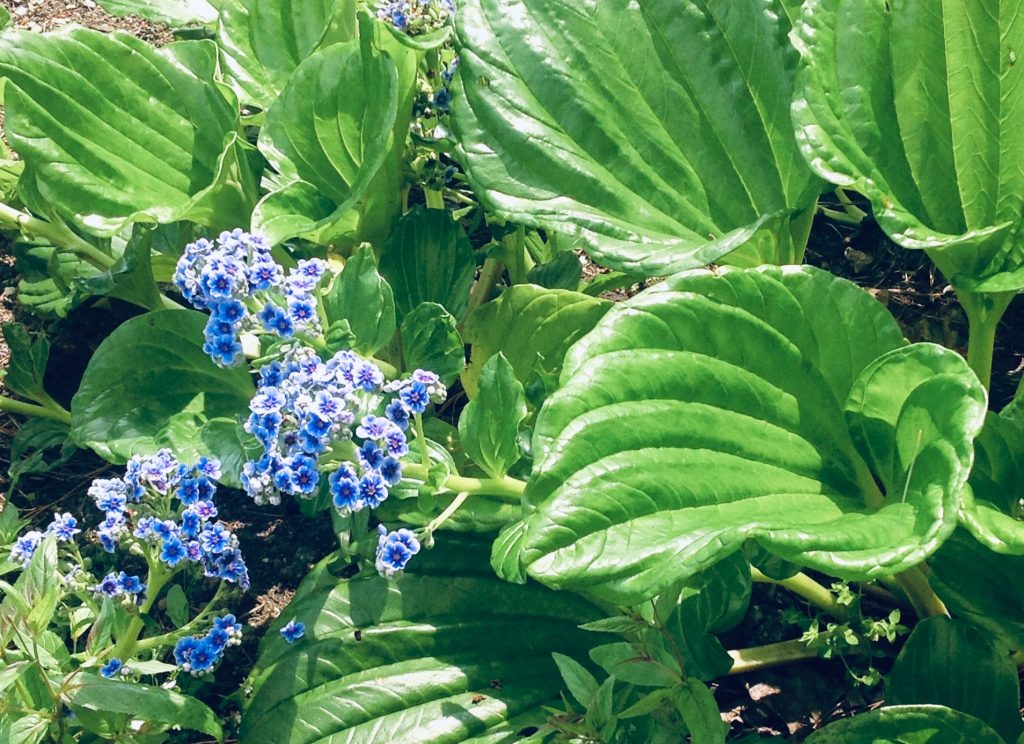
Omphalodes cappadocicca is another useful ground cover plant. Evergreen, with nice glossy dark leaves, in May it sends up sprays of mid blue flowers like forget-me-nots on steroids.
Parochetus communis is a great ground cover if you want a real invader or you can trap it – as I have – between a wall and a path or drive. From the mountains of Asia and tropical Africa, it is evergreen with very pretty clover-like leaves that never look tired unless frosted badly. The true blue flowers are small ‘pea’ flowers in clusters of 2-4 on short stems throughout autumn and winter. They cheer up a gloomy winter’s day.
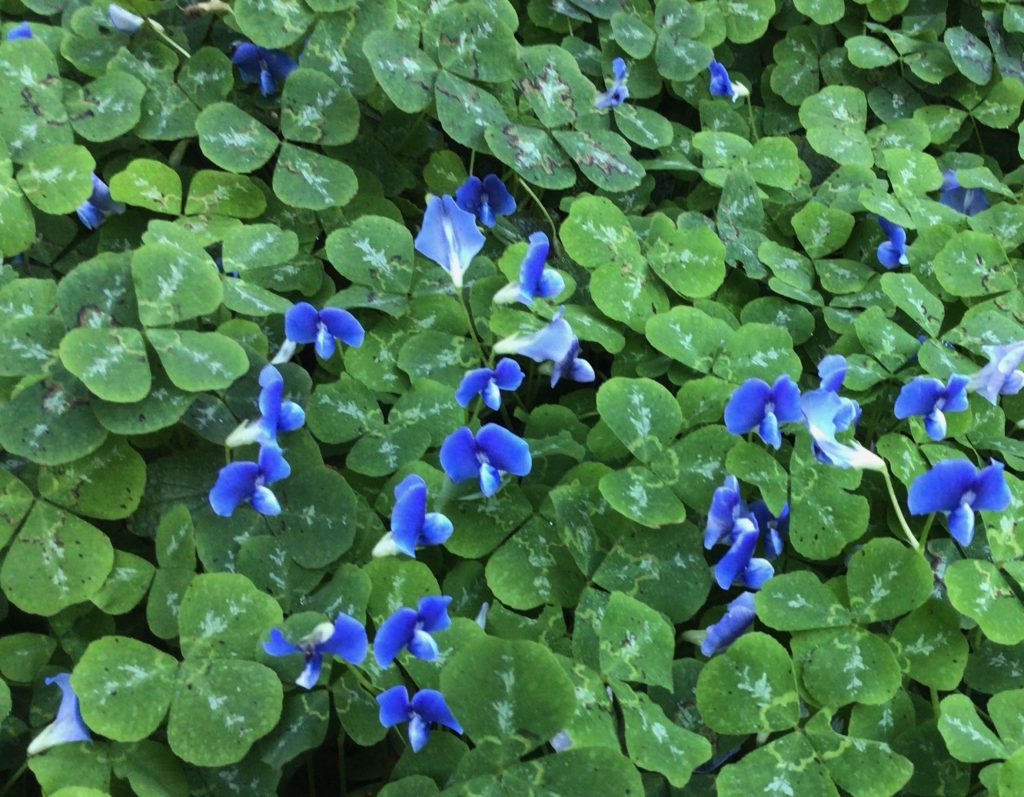
Salvias – several have true blue flowers – S. corrugata, S. patens, S. uliginosa, S.sagittata, S.cacaliifolia.
I had all of these outside until last winter’s wet killed off S. corrugata, S. uliginosa and S. sagittata. S. corrugata is a sub-shrubby evergreen with deeply corrugated leaves and furry, navy blue flowers in late summer. S.sagittata is a rather leggy perennial with arrow shaped leaves and small sprays of mid blue flowers in late summer – more interesting for its foliage than the flowers. S.cacaliifolia Is a neater plant with triangular leaves and better sprays of small, mid-blue flowers. S.uliginosa is usually quite a hardy perennial but likes it a bit drier. It has slight stems that grow over a metre high, topped with small sky blue flowers in neat inflorescences. It is lovely filtering through other plants. Standing alone, it tends to get blown over in the wind but there is a shorter version of it on the market now. S. patens is the show off of this group with large hooked flowers in royal blue on long extending inflorescences. Cuttings overwintered inside will flower from June till the frost hits. Outside, on a dry border, it overwinters but emerges late in June or even July so doesn’t start to flower until August.
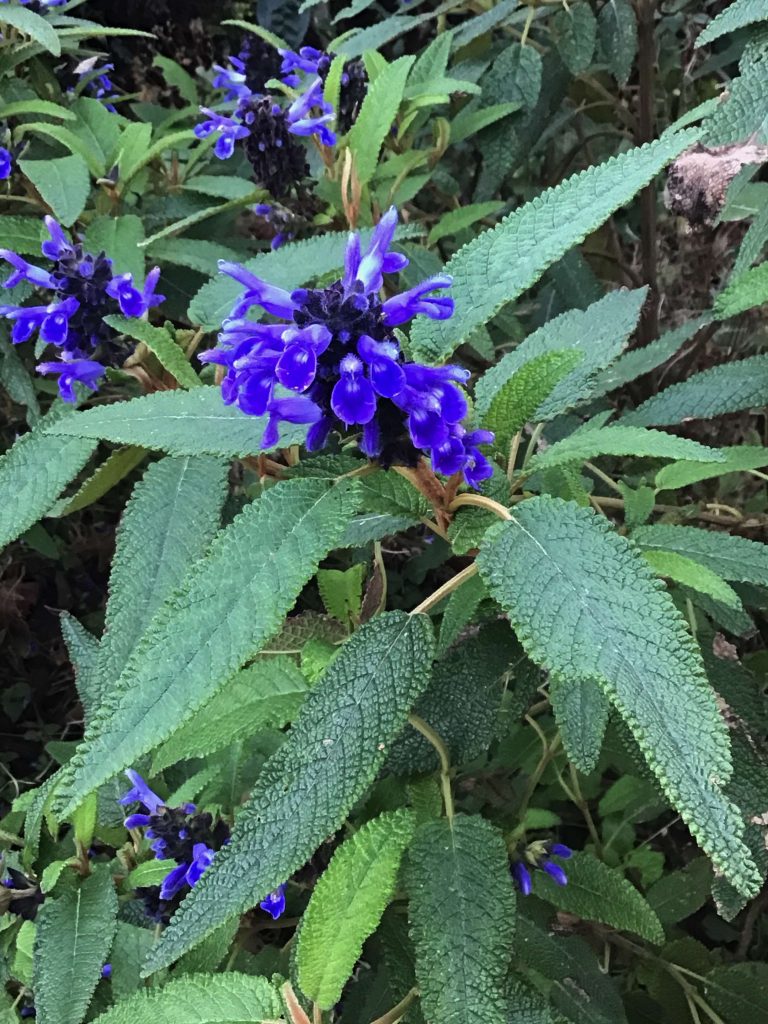
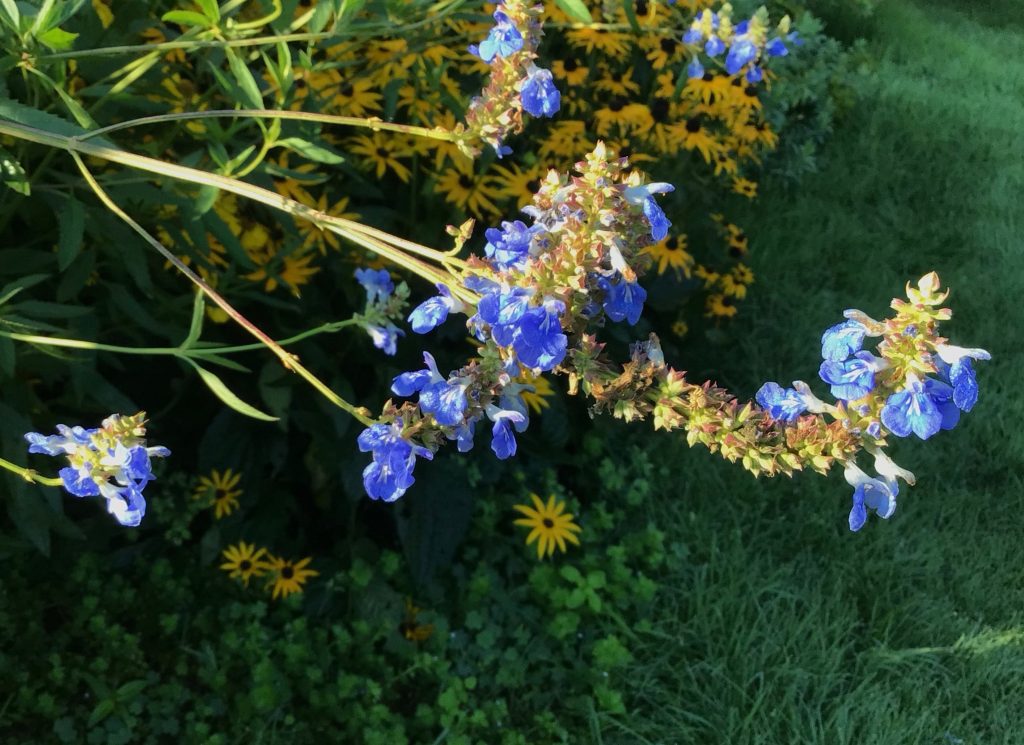
Veronicas
I’ve just got hold of Veronica prostrata Blue Mirror. I’ve had a pink version for years and it’s one of the best small creeping ground covers there is. It is dense and evergreen and grows just about anywhere though it flowers best in the sun. Veronica gentianoides is another useful front-of-bed plant with evergreen leaves that lie flat on the ground and send up 45 cm spires of ice-blue flowers. Veronica austriaca subsp,teucrium Crater Lake Blue is another good front of border evergreen that sends up spires of intense blue flowers.
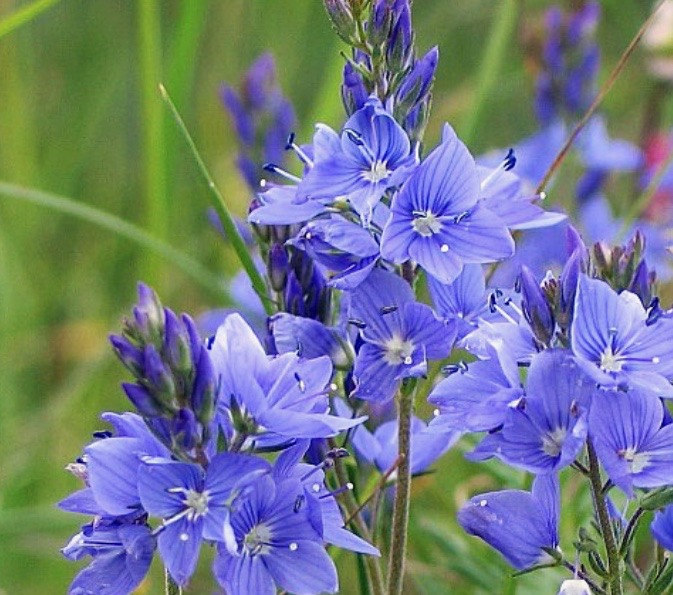
Shrubs
I can think of very few good blue-flowered shrubs:
Ceanothus is a genus of 50+ species native to North America, many of which are blue. The most frequently grown are cultivars of C. arboreus and C. thyrsiflorus. These are both evergreen shrubs from California which can be left to grow into small trees but look their best if kept lower and denser by cutting back immediately after flowering. My favourite cultivars are Skylark – an intense mid blue, and Concha – which does have true blue flowers but its purple-ish bracts slightly contaminate the blueness.
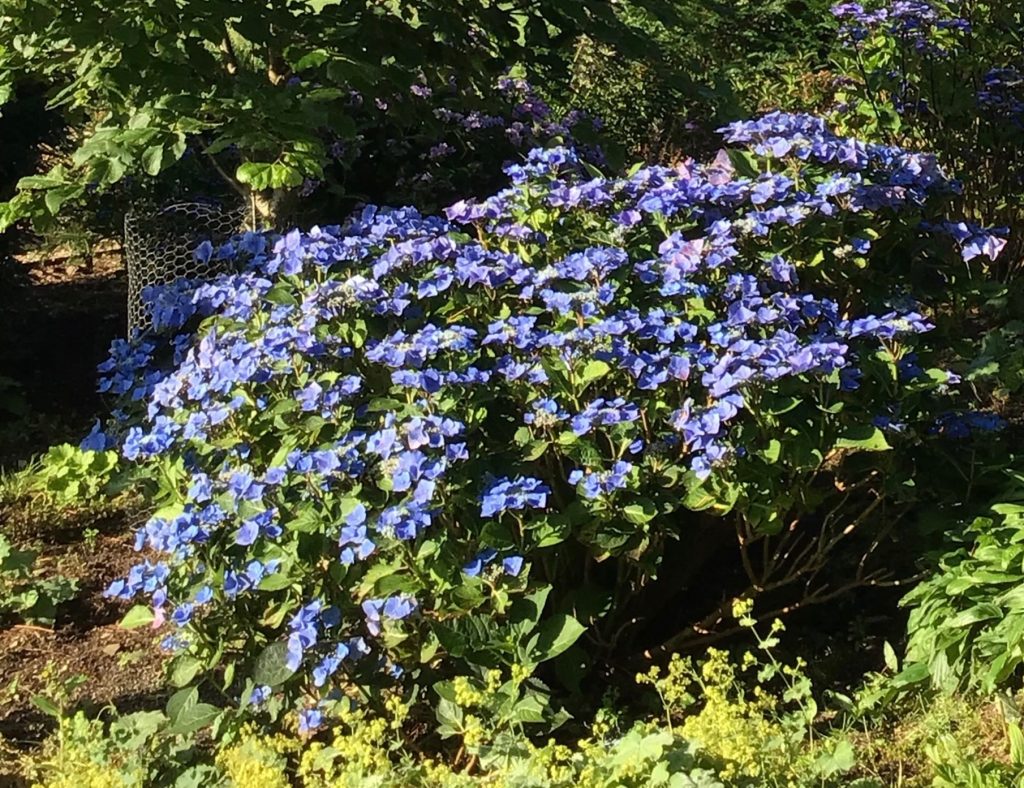
Ceratostigma plumbaginoides is a very sub sub-shrub that spreads slowly and has clusters of pure blue flowers. Its grown-up cousin C. wilmottiana has much more impact – again with clusters of bright blue flowers but it makes a proper small shrub and flowers from July to November.
Hydrangeas
Most ‘blue’ Hydrangeas have quite a lot of red pigments in them – in fact the same pigment that makes them blue also makes them pink and it’s the pH of the soil that alters the pigment’s light wavelength absorption. Some do show a true blue – at least in acid soils. I think the best is Teller’s blue – a lacecap type with smallish bright cerulean blue tepals. Dichroa is a genus now subsumed into Hydrangea. I have a young Dichroa febrifuga and it’s still on the ‘try it out but I’m not sure I like it’ list. It has small light blue flowers in medium sized clusters and should have metallic blue berries to follow but I haven’t seen any yet.


Climbers
Sollya heterophylla – the bluebell vine – I mention it only to dismiss it – I think this a sorry thing, weak stems and tiny nodding (though true blue) bells. It’s a ‘why bother’ in my book.
Ipomoea – Morning Glory. Several have true blue flowers – some cultivars of Ipomoea nil – the Japanese Morning Glory and Ipomoea tricolor, the Mexican Morning Glory. We grow these as annuals from seed though they are perennial in their native habitat. Like our native bindweed – they grow fast and furious and can cover a fence or a shed in one season.
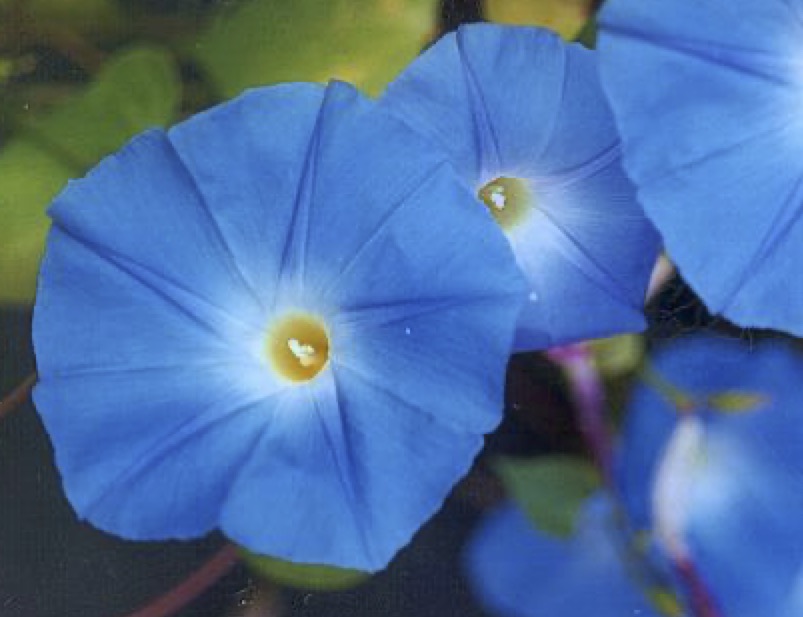
Bulbs
Blue bells: Our native bluebell – Scilla non scripta are not truly blue – look carefully at them next spring and you’ll see that they have distinct blue and purple parts to the flower. It’s this that makes them so vibrant. Other Scillas are truly blue –Scilla siberica are small bright blue spring flowers that would thrive on a dry bank. And there are other small, blue, bell-flowered bulbs – Pushkinia scilloides is ice blue, Chionodoxa forbesii is bright royal blue, and several Muscari -grape hyacinth species are blue though others err on the purple side.
Singing the blues:
I think the best companion colours to make the true blues sing are yellows or white with lime green. I have seen blue and purple put together effectively – it zaps up both colours but it isn’t easy on the eyes.
Incidentally – why is feeling low expressed as being blue? Surely grey or beige would describe it better and is it blue in all cultures?

